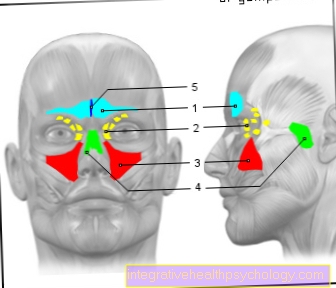The foramen oval of the heart
Definition - What is the foramen ovale?
The heart consists of two atria and two chambers, which are usually separated from each other. The foramen ovale, however, represents an opening, which in the fetus causes blood to pass from the right atrium into the left atrium. Normally, blood would travel from the right atrium to the right ventricle and through the pulmonary circulation to the left atrium. In the fetal circulation, the pulmonary circulation is largely left out of the blood circulation, which is made possible functionally by the short circuit via the foramen ovale. The reason for the redirection of the blood is that the lungs of the fetus cannot yet take on a respiratory function and therefore initially only has to be supplied with a small amount of blood. The foramen ovale closes during the birth process and the function of the lungs.

Heart anatomy
The heart is composed of a right and a left atrium and a right and a left ventricle. Between the two atria is the atrial septum that divides the heart into a right and a left half. Compared to the ventricular septum, the atrial septum is thinner and has a thinner muscle layer.
The blood reaches the right atrium via two large body veins, the inferior vena cava and superior vena cava. From there, the blood is directed into the right ventricle and further into the pulmonary circulation. The oxygen-enriched blood from the pulmonary circulation returns to the left atrium via the pulmonary veins. Here it is passed on to the aorta via the left ventricle and thus reaches the large body circulation.
In the fetal circulation, there is an opening between the right and left atriums called the foramen ovale. This opening is absolutely normal because the lungs in the fetal circulation are not yet ventilated.
After birth, when the pulmonary circulation is opened, changes in pressure within the heart lead to a change in the blood circulation, now via the right ventricle and the pulmonary circulation into the left atrium.
The foramen ovale is no longer needed, so that it usually closes quickly. If the foramen ovale does not close or only partially closes, pathological symptoms can occur.
What role does the foramen ovale play in the baby?
After the birth and as a result of a baby's first breaths, there is a change in pressure within the lungs and heart. The blood is no longer passed through the foramen ovale, but instead goes through the natural circulation of the lungs and body. The foramen ovale is no longer needed and is usually closed by fusing the atrial septum layers. This results in a complete delimitation of the right side of the heart from the left side of the heart.
The closure of the foramen ovale by fusing the septum usually takes place within the first days or weeks after birth. However, the closure can take longer than a few weeks or even never take place completely in the course of life. This does not necessarily have to be a malignant disease. Depending on the size of the foramen oval and possible combined heart defects, life without necessary treatment is possible or not. However, an examination by a specialist should always be carried out.
What is a forum ovale apertum / persistens?
If the foramen ovale does not or incompletely close after birth, a foramen ovale apertum, also known as the persistent foramen ovale, occurs.
Normally, after the lungs have been ventilated as a result of a baby's first breaths, the blood is carried through the pulmonary circulation further into the left atrium. The foramen ovale is therefore no longer necessary and closes over time. In some babies, however, there is no closure of the septum, which leads to the persistent foramen ovale. In most cases, however, the disease value is very low and no mandatory treatment is necessary, as the heart automatically circulates the blood through the pulmonary circulation through high pressures in the left atrium and correspondingly lower pressures in the right atrium. In a healthy heart with no other heart defects, only a small proportion of the blood is transferred between the atria via the foramen ovale. A kind of valve-like closure occurs. This unclosed foramen ovale occurs in about 25% of people.
If there is an excessive crossover through the foramen ovale, for example due to a change in pressure, more blood can cross from the right side of the heart to the left side of the heart without passing through the pulmonary circulation. Since one of the tasks of the lungs, in addition to enrichment with oxygen, is also filtering, more and more oxygen-poor and unfiltered blood is transported directly into the large body circulation via the foramen ovale. Depending on the amount of this blood, this can cause symptoms such as shortness of breath, decreased performance or migraines.
Paradoxical embolism
A paradoxical embolism, also known as “crossed embolism”, is the name given to the passage of a blood clot (embolus) from the venous to the arterial part of the bloodstream. The reason for this is a defect in the area of the heart septum, mostly due to an unclosed foramen ovale. When the foramen ovale is closed, the lungs take over the function of filtering possible thrombi.
As a rule, after birth, when the pulmonary circulation is opened, even with an open foramen ovale, hardly any blood passes from the right to the left atrium. The reason for this is a strongly regulated pressure gradient within the heart, which dictates the direction of flow of the bloodstream. If this pressure gradient changes with an open foramen ovale, excessive crossover through the open atrial septum can occur. In the process, a clot can also pass over and consequently enter the arterial circulatory system directly.If this now clogs blood vessels, it can become blocked, which is noticeable symptomatically.
Read also: embolism
The change in pressure can have many different causes, such as coughing, sneezing, straining or a pulmonary embolism.
Read more on this topic in our dedicated article: Paradoxical Embolism
What role does the foramen ovale play in a stroke case?
One of the many causes of stroke can be an unclosed foramen ovale. This form of stroke is known as cryptogenic stroke. In this regard, cryptogenic only means that none of the classic causes caused the stroke.
If the foramen ovale is not closed, small venous thrombi can enter the left atrium directly from the right atrium. This allows a quick and easy transition into the large body circulation. The pulmonary circulation is simply left out - the thrombus is passed from the right to the left atrium and from there directly to the left ventricle and the aorta, which means that such a thrombus can also reach the brain quickly.
Please also read: Stroke- These are the signs or symptoms of preventing a stroke
How can the foramen ovale be closed?
In adults, the foramen ovale can be closed by minimally invasive interventions.
A small incision is made in the groin, whereby a tube system (catheter) can be inserted and advanced through the blood vessels to the heart. A small implant in the form of an umbrella can then be inserted into the open foramen ovale on the heart. The umbrella consists of two parts, which are made from a soft wire mesh. One of the parts is placed on the opening of the foramen ovale in the right atrium, while the other part is placed on the opening of the foramen ovale in the left atrium. The two parts are connected by a small bridge through the opening of the atrial septum. Over the course of a few days, the wire meshes grow into the heart wall, which leads to the final closure of the foramen ovale.
The procedure takes between one and two hours and is performed in a cardiac catheter laboratory. The inserted implant can remain in the heart for a lifetime, provided there are no symptoms.
However, such an intervention is not universally recommended. Depending on the size of the foramen ovale and any existing symptoms, medical intervention by thinning the blood may be sufficient or even no treatment at all may be necessary.
Do I need blood thinning with a foramen ovale?
In the case of an open foramen ovale, it is not absolutely necessary to use blood-thinning drugs.
Thrombi can pass through the foramen ovale, which is why the foramen ovale indirectly increases the likelihood of a possible stroke in the brain or further embolisms within the great circulation. By diluting the blood, the likelihood of a basic thrombus formation can be reduced enormously.
However, blood-thinning medications can also have negative consequences as they increase the risk of bleeding. The drug setting should therefore be discussed in detail with a doctor.
You might also be interested in this articlen: anticoagulants
Function of the foramen ovale
The main function of the foramen ovale is to transport the blood from the right to the left atrium, thus avoiding that the blood is passed through the pulmonary circulation.
The lungs are not yet ventilated in the fetal circulation. The fetus is supplied with oxygen via the placenta. Based on these facts, there is no need to provide excessive blood flow to the lungs. Only a small proportion of the blood has to get into the lungs to supply the tissue and the formation of the pulmonary vessels.
Due to a pressure gradient within the heart and lungs, most of the blood is directed to the left atrium via the foramen ovale. This pressure gradient plays a crucial role after birth. At birth, the pressure in the pulmonary circulation is decreased as the lungs expand while pressure in the left atrium is increased. Blood always takes the path of least resistance that prevails in the lungs due to the change in pressure. As a result of these changes in pressure, the blood conduction changes and the foramen ovale is then closed. The blood is no longer conducted through the foramen ovale, but now takes up the natural blood circulation of a healthy person with the blood being conducted through the lungs.
The ductus arteriosus Botalli represents a similar form of bypassing the pulmonary circulation. However, this is not an opening of the septum, but is made possible by a physiological vascular connection between the pulmonary artery (Truncus pulmonalis) and the aorta.

























-de-quervain.jpg)



